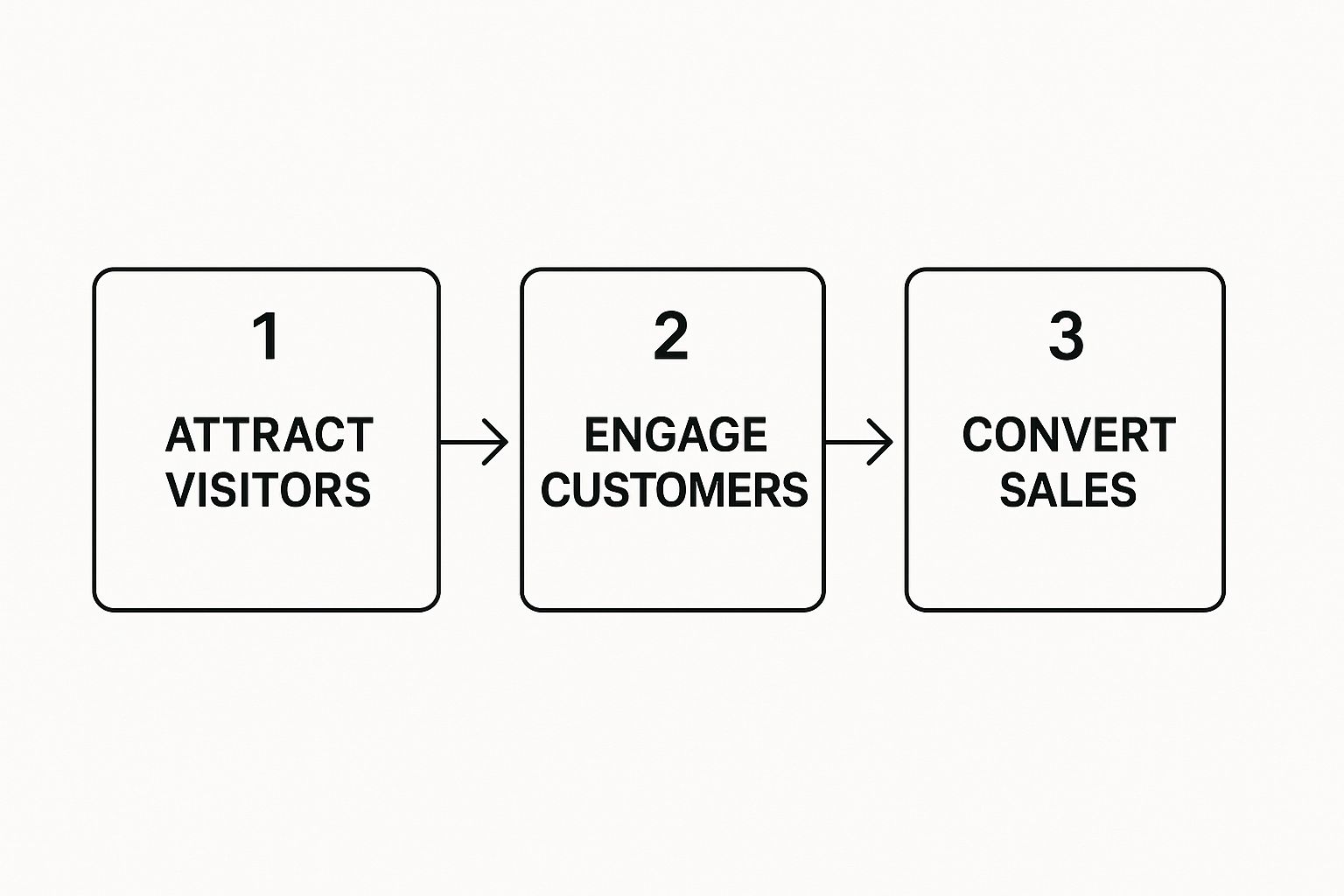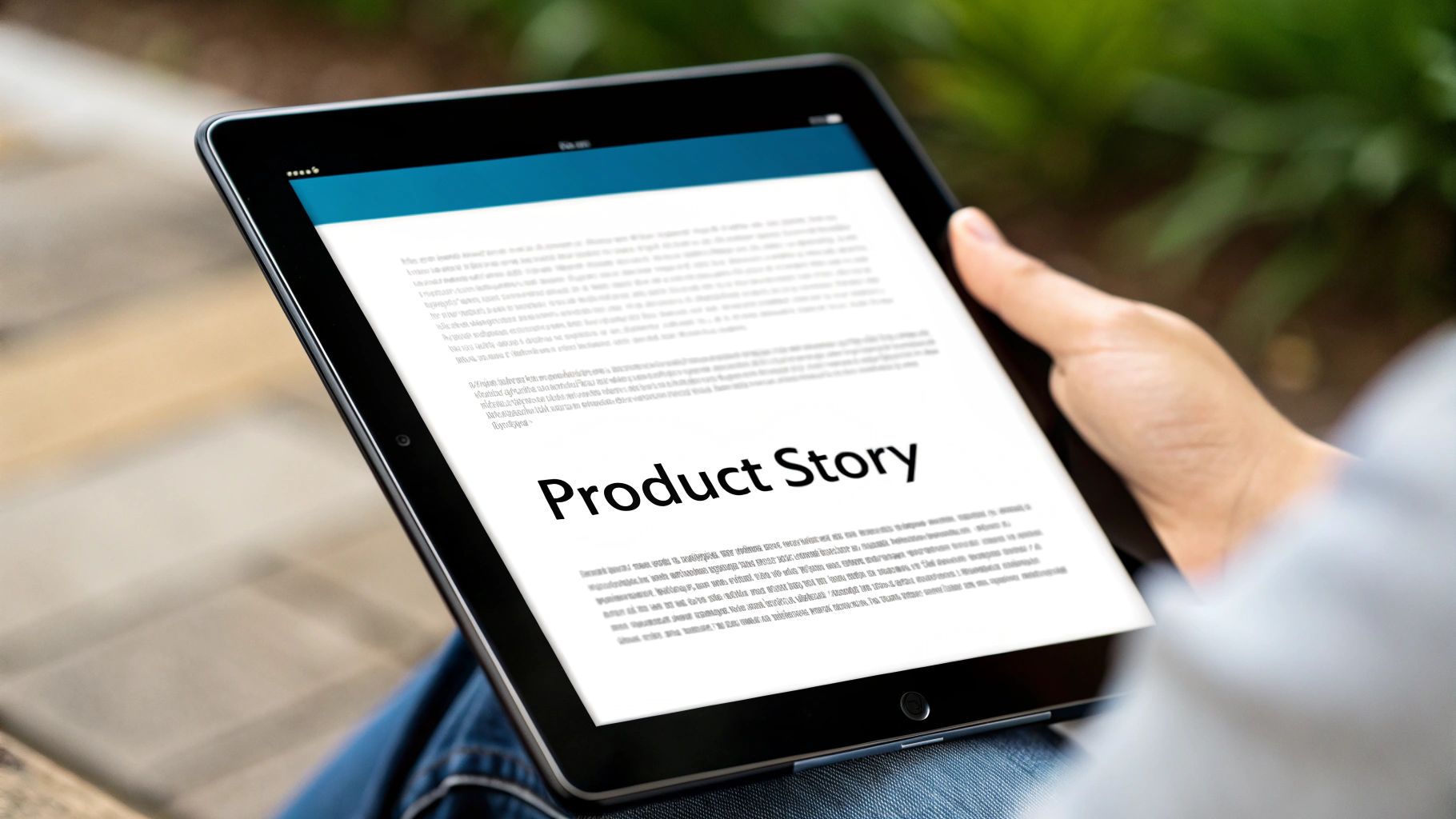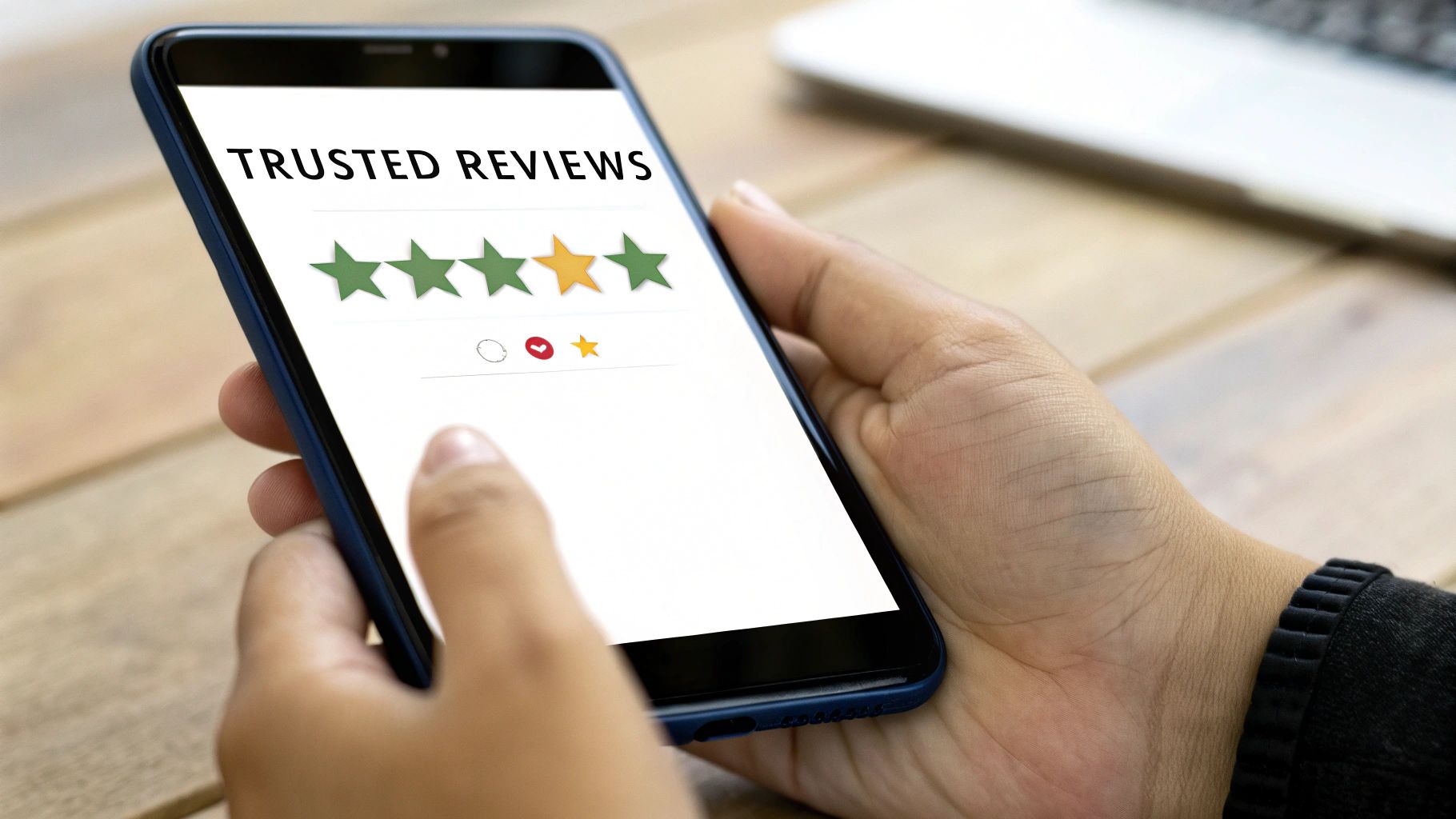How to Improve Ecommerce Sales: Proven UK Strategies

How to Improve Ecommerce Sales: Proven UK Strategies — To really boost your ecommerce sales, you need to get three things right: creating a buttery-smooth mobile shopping experience, sharpening your paid ad campaigns, and constantly tweaking your landing pages and checkout process. Your customers are on their phones more than ever, so treating mobile as an afterthought is a surefire way to leave money on the table.
How to Improve Ecommerce Sales: Build a Mobile-First Ecommerce Experience
For years, we’ve heard the term “mobile-friendly.” It’s time to throw that thinking out the window. In today’s market, you have to be “mobile-first.” This isn’t just a buzzword; it’s a fundamental shift in how you should approach design. It means you build the entire shopping journey for the small screen first, then adapt it for desktop – not the other way around.
Why the urgency? Because that’s where your customers are. The data is impossible to ignore. A staggering 69% of UK online purchases now happen on smartphones. This isn’t a slow creep; it’s a decisive shift, especially with younger shoppers. Gen Z, who make up 55% of the online consumer base, live on their phones. If your mobile experience is clunky, you’re alienating a massive, and growing, part of your market. To really get a handle on this, it’s worth exploring the full breakdown of mobile shopping statistics.
Optimise for Speed and Simplicity
On a mobile device, speed isn’t a “nice-to-have.” It’s everything. A slow-loading site is the quickest way to send a potential customer straight to your competitor. Think about it: even a one-second delay in page load time can slash your conversions by up to 7%. That’s a direct hit to your bottom line.
Your main goal should be getting your site to load in under three seconds on a standard mobile connection. It sounds tough, but it’s achievable. Here’s where to focus:
- Image Compression: This is a big one. Use modern formats like WebP and make sure every single product photo is compressed without looking pixelated. One huge, unoptimised image can bring your whole site to a crawl.
- Minimising Code: Every plugin, app, or third-party script you add to your site adds weight. Be ruthless. If it’s not essential for the user experience or core functionality, get rid of it.
- Leveraging Browser Caching: Set up your site to store static files—like your logo, CSS, and fonts—in the user’s browser. This means on their next visit, the page loads almost instantly because their device already has most of the components.
Beyond raw speed, simplicity is king. You’re working with limited real estate. A cluttered interface or confusing navigation is a recipe for frustration and will send your bounce rate through the roof.
We have a simple rule for mobile design: if an element doesn’t help a shopper find what they want or make a purchase, it’s just getting in the way. Ditch it.
This process is about guiding visitors smoothly from discovery to checkout.

As the visual shows, every stage of the journey needs to be optimised. A single point of friction can derail the entire sale.
Design an Intuitive Mobile Checkout (How to Improve Ecommerce Sales)
The checkout is the final hurdle, and it’s where so many online stores stumble, especially on mobile. A long, convoluted checkout process is the number one killer of conversions and a major reason for abandoned carts. Your goal is to make paying for an item so easy and fast that the customer doesn’t have a second to reconsider.
Just look at the mobile checkout for a major UK retailer like ASOS. It’s a masterclass in frictionless design. They ask for the bare minimum, offer express payment options like Apple Pay and Google Pay, and show all costs upfront. No surprise shipping fees, no being forced to create an account. It just works.
To get started, we’ve put together a table outlining the key areas to focus on for a high-converting mobile experience.
Key Areas for Mobile Commerce Optimisation
| Optimisation Area | Core Objective | Example Tactic |
|---|---|---|
| Site Speed | Load pages in under 3 seconds. | Compress all images using modern formats like WebP. |
| Navigation | Make finding products effortless. | Use a clear, “sticky” header with a prominent search bar. |
| Checkout Flow | Minimise steps to purchase. | Enable guest checkout and offer digital wallets (Apple Pay, PayPal). |
| Form Fields | Reduce typing and user effort. | Use address auto-complete and only ask for essential information. |
By implementing these tactics, you can transform your mobile site from a potential bottleneck into your most powerful sales channel. Here are some actionable steps you can take today to improve your own checkout:
- Enable Guest Checkout: Never, ever force a new customer to create an account. It’s one of the biggest conversion killers.
- Offer Digital Wallets: Integrate one-click payment options. Apple Pay, Google Pay, and PayPal are non-negotiable. They pre-fill all the details, making the purchase almost effortless.
- Use a Progress Bar: Show people where they are in the process (e.g., “Step 2 of 3”). It manages expectations and stops them from feeling like the process is endless.
- Simplify Form Fields: Cut down the number of fields to the absolute essentials. Use tools like address auto-lookup to save customers from tedious typing.
Nail these core areas—speed, simplicity, and a slick checkout—and you’ll be well on your way to turning those mobile visitors into loyal, paying customers.
How to Improve Ecommerce Sales: Refine Your PPC and Paid Advertising Campaigns

Getting people to your site is one thing; getting the right people who actually buy from you is a whole different ball game. If your Pay-Per-Click (PPC) campaigns are just ticking over on autopilot, I can almost guarantee you’re burning money. To really boost your ecommerce sales, you have to treat your paid ads like a precision instrument—always tuning, always refining.
It’s about so much more than just throwing bids at the most obvious keywords. A winning strategy is one where your ad copy, your targeting, and your landing pages all work in perfect harmony to guide a potential customer straight to the checkout. We see a lot of UK businesses stumble here, treating PPC as just another expense instead of the powerful growth engine it can be.
Here’s a classic mistake we see all the time: brands get obsessed with driving clicks instead of profitable conversions. A click that costs you £2 but goes nowhere is a loss. A click that costs £5 but results in a £100 sale? That’s a huge win. Your mission is to find more of the latter.
Let’s get into the practical ways you can sharpen up your campaigns and stop leaving cash on the table.
Structure Your Campaigns for Maximum Relevance
A messy, disorganised ad account is an inefficient one. If you’re just dumping hundreds of keywords into one massive ad group, your ad relevance will tank, your Quality Scores will plummet, and your costs will creep up. The secret is to build tightly themed ad groups.
Think about a UK-based online shoe shop. A single ad group for “women’s shoes” just won’t cut it. Instead, they should have specific campaigns and ad groups broken down like this:
- Women’s Running Trainers UK: This targets people actively looking for athletic footwear.
- Black Leather Ankle Boots: A much more specific, high-intent search. These users know what they want.
- Vegan Suede Heels: This hones in on a niche audience with very specific values.
This kind of granular structure lets you write incredibly specific ad copy that perfectly matches what the person searched for. Someone typing “black leather ankle boots” is far more likely to click an ad with that exact headline than a generic “Shop Women’s Shoes” message. Getting this alignment right—between keyword, ad, and landing page—is fundamental to better PPC performance.
Craft Compelling Ad Copy That Sells (How to Improve Ecommerce Sales)
Your ad copy is your three-second elevator pitch. It has to grab attention, show your value, and give someone a solid reason to choose your ad over the ten others on the page. For UK shoppers, that means using familiar language, shouting about the benefits that matter, and building a bit of trust.
Here’s a quick look at weak vs. strong ad copy for, say, a skincare brand:
| Ad Copy Element | Weak Example | Strong Example |
|---|---|---|
| Headline | Buy Skincare Products | Natural Skincare Made in the UK |
| Description | We sell a wide range of face creams and serums. | Soothe your skin with our award-winning organic serum. Free next-day delivery on all orders. |
| Call-to-Action | Click Here | Shop the Collection & Save 15% |
The strong example is miles better. It’s specific (“organic serum”), it builds trust (“award-winning,” “Made in the UK”), and it throws in a clear incentive (“Free next-day delivery,” “Save 15%”). It speaks directly to what a UK shopper looks for: local quality and good delivery terms. For a deeper dive into this, our guide on effective PPC management strategies for UK SMEs is packed with advanced techniques to maximise your return.
Go Beyond Clicks with Smart Bidding and Remarketing
Once your account structure is solid, it’s time to get clever with your bidding. Stop just paying for clicks and start using automated strategies like Target ROAS (Return On Ad Spend). This tells Google to aim for a specific return for every pound you spend, meaning it will automatically bid higher for users it thinks are more likely to make a valuable purchase.
Remarketing is your other secret weapon. But don’t just blast the same generic ad at everyone who’s ever visited your site. Get granular with your audiences:
- Homepage Visitors: Show them ads that highlight what makes your brand special or feature your best-selling products.
- Product Page Viewers: Follow up with the exact product they were looking at. A little “Limited Stock!” message can add a sense of urgency.
- Cart Abandoners: This is your golden ticket. Hit this group with your best offer—maybe a 10% discount or free shipping—to nudge them over the finish line.
By tightening up your ad structure, sharpening your copy, and using smart bidding and remarketing, you can transform your PPC campaigns from a simple traffic tap into a sophisticated sales machine.
How to Improve Ecommerce Sales: Enhance Your Landing Pages and Product Feeds

Your PPC ads and social campaigns have done their job—they’ve brought a shopper to your virtual doorstep. But what happens once they’re inside? This is where your landing pages and product feeds have to take over. They are your digital shopfront and your best salesperson, all rolled into one. A clunky page or a messy product feed can bring the entire customer journey to a screeching halt.
Think about it. You wouldn’t pour a fortune into a stunning high-street window display only to lead customers into a cluttered, confusing shop. The same logic applies online. To really drive more ecommerce sales, you need to create a seamless and persuasive path from that very first click all the way to the “buy now” button.
This all comes down to two core assets: the pages where customers land, and the data that fuels your shopping ads.
Crafting a High-Converting Landing Page (How to Improve Ecommerce Sales)
Your landing page has one job: turn a visitor into a customer. Simple as that. Every single element on that page needs to be pushing towards this goal. Any friction, confusion, or hint of untrustworthiness will send potential buyers clicking away, probably for good.
Here are the absolute essentials you need to nail:
- Persuasive, Clear Copy: Your headline must instantly reassure the visitor they’re in the right place. Product descriptions should do more than just list features; they need to sell the benefits and solve a problem for the shopper. Tell a story with benefit-driven language.
- High-Quality Imagery and Video: Online shoppers can’t touch or feel your products, so your visuals have to do all the heavy lifting. Include multiple high-resolution images from every conceivable angle, a 360-degree view if you can, and lifestyle shots showing the product in action. A short video can make a huge difference to conversion rates.
- A Crystal-Clear Call-to-Action (CTA): Your “Add to Basket” or “Buy Now” button should be impossible to miss. Use a colour that contrasts with the rest of the page and use direct, action-focused text.
- Essential Trust Signals: Without a face-to-face interaction, building trust is everything. Display customer reviews and ratings prominently. Show off security badges (like SSL certificates and payment logos) and have clear, easy-to-find information on your delivery and returns policies. A recent study found that 90% of shoppers see the post-purchase experience as being just as important as product quality.
A landing page isn’t just a catalogue entry; it’s your most dedicated salesperson. It needs to answer questions, build confidence, and make the decision to buy feel both easy and smart. If it’s failing at any of these, it’s costing you sales.
By meticulously optimising these elements, you chip away at doubt and build the momentum needed to guide the shopper towards making that purchase.
Optimising Your Google Shopping Product Feed
If you’re running Google Shopping campaigns, your product feed is the engine. A well-oiled feed ensures your products show up for the right searches, display accurate information, and stand out from the crowd. A neglected one, on the other hand, is a one-way ticket to ad disapprovals and wasted budget.
Too many businesses treat their feed as a “set it and forget it” task, which is a massive mistake. Your feed needs constant attention to perform at its peak. You should be focused on enriching the data with specific, relevant attributes that help Google connect your products to what people are actually searching for. For a deep dive, check out our guide on mastering your Google Shopping product feed.
To get you started, here are the most critical areas for optimisation:
- Product Titles: This is arguably the most important part of your feed. Don’t just use the basic product name. Structure your titles logically, with the most important keywords first. A solid formula is Brand + Product Type + Key Attributes (e.g., Colour, Size, Material). For example, “Nike Air Max Trainers Men’s Size 9 Black” is infinitely more powerful than just “Air Max Trainers.”
- Product Images: Use a clean, white background for your main image and make sure it’s high-resolution. Then, use your additional image slots to show the product from different angles and in a real-world context. Help the customer visualise it.
- Product Category: Be as specific as you possibly can with Google’s Product Category
[google_product_category]attribute. Don’t just settle for “Apparel”; drill right down to “Apparel & Accessories > Clothing > Outerwear > Coats & Jackets.” This level of precision helps Google understand exactly what you’re selling. - Enriching Key Attributes: Make full use of all the optional attributes. If you’re selling clothing, you absolutely must include
colour,size,gender, andage_group. The more high-quality data you feed Google, the better it can target your ads, leading directly to higher-quality traffic and a real improvement in your ecommerce sales.
How to Improve Ecommerce Sales: Use Data to Understand UK Consumer Behaviour

Making smart decisions to boost e-commerce sales isn’t about guesswork. It’s about listening to the stories your data is telling you. In today’s crowded marketplace, the brands that truly win are the ones that understand what their customers want—sometimes even before the customers themselves realise it.
This means you need to look beyond basic sales figures and dive deep into consumer behaviour analytics. Every click, search, and purchase on your site is a breadcrumb. When you piece them together, you get a clear picture of who your customers are and what makes them tick. Your best friends here are tools like Google Analytics and your own e-commerce platform’s dashboard. They’re goldmines of information, holding the keys to purchasing patterns, top products, and how your prices influence buying decisions.
From Raw Data to Actionable Insights (How to Improve Ecommerce Sales)
Staring at a dashboard full of numbers can be daunting. The real goal isn’t just to collect data, but to make sense of it. The best way to start is by focusing on a few key performance indicators (KPIs) that are directly tied to your sales.
It’s about more than just website traffic. Your most valuable metrics should paint a picture of the entire customer journey:
- Conversion Rate by Traffic Source: This tells you which channels (like organic search, paid ads, or social media) are bringing in visitors who actually buy something. It’s your guide on where to double down on your marketing budget.
- Average Order Value (AOV): Knowing how much the average customer spends in one go is vital. If your AOV is low, you can introduce strategies like product bundling or smart upsells at checkout to push it higher.
- Customer Lifetime Value (CLV): This metric shows how much revenue a single customer brings to your business over their entire relationship with you. A high CLV is a sign of a healthy business with strong customer loyalty.
Don’t get distracted by vanity metrics. A million website visitors mean nothing if none of them convert. Focus on the data that directly links to revenue and customer behaviour. That’s the bedrock of a solid, data-driven sales strategy.
By keeping a close eye on these KPIs, you can stop just reacting to market shifts and start proactively shaping your customers’ experiences.
Segment Your Audience for Personalised Marketing (How to Improve Ecommerce Sales)
One of the most powerful ways to improve your e-commerce sales is to stop treating all your customers as one big, faceless group. Your audience is made up of different segments, each with its own unique needs, preferences, and buying habits. Data is what allows you to find these groups and talk to them directly.
Think about these practical ways to segment your audience:
- New vs. Returning Customers: A first-time visitor needs to be convinced your brand is credible. You should be showing them trust signals, welcome offers, and your best-selling products. A returning customer, on the other hand, will respond better to loyalty rewards or recommendations based on what they’ve bought before.
- High Spenders: Identify your VIP customers who consistently spend more. You can create exclusive offers or give them early access to new products, making them feel valued and encouraging them to keep coming back.
- Cart Abandoners: This is a group of people with high intent who just need a final nudge. A targeted email with a small discount or a simple reminder of the items they left behind can be incredibly effective at recovering what would otherwise be lost sales.
The UK’s wider retail environment highlights just how important this data-led approach is. With total retail sales projected to hit £599.07 billion, and a massive 30.7% of that spending happening online, understanding consumer trends is non-negotiable if you want to capture your share of the market.
By using data to segment your audience, you can deliver marketing messages that are highly relevant and resonate on a personal level. This personalised approach is far more effective than any generic, one-size-fits-all strategy. If you’re looking to apply these insights to your paid advertising, you might find our guide on e-commerce PPC tips to drive sales for your UK store useful.
How to Improve Ecommerce Sales: Master Your Conversion and Checkout Optimisation
You’ve done all the hard work. You’ve attracted a shopper to your site, they’ve browsed your products, found something they love, and even added it to their basket. This is the moment of truth. Don’t let all that effort go to waste at the final hurdle.
Getting your conversion and checkout optimisation right is all about making this final step as seamless, trustworthy, and fast as possible. The slightest bit of friction here can make a shopper second-guess their decision and abandon their cart for good. We’re talking about the small, strategic tweaks that remove doubt and pave a clear, effortless path to purchase. These adjustments are often what separate a lost opportunity from a completed sale.
Eliminate Friction in the Checkout Flow
Think of your checkout process like the express lane at the supermarket. The goal is pure speed and efficiency. A long, complicated checkout is the number one killer of conversions and the main reason for cart abandonment. Your mission, should you choose to accept it, is to cut out every single unnecessary step and field standing between your customer and their purchase.
Start by only asking for the absolute bare minimum. Do you really need their phone number if you aren’t doing SMS marketing? Could you capture their address with a single postcode lookup tool instead of making them fill out four separate lines? Every field you remove is a win for your conversion rate.
A huge, and surprisingly common, mistake is forcing customers to create an account before they can buy. It’s a massive conversion killer. Always, always offer a prominent guest checkout option. You can always prompt them to create an account on the “Thank You” page after the sale is safely in the bag.
This approach respects your customer’s time and, most importantly, secures the sale with the least amount of fuss.
Build Trust When It Matters Most (How to Improve Ecommerce Sales)
The moment a customer pulls out their credit card is when their trust in your brand is put to the ultimate test. They’re at their most vulnerable, and even the slightest hint of insecurity can send them running for the hills. You need to plaster your checkout page with signals that scream “you can trust us”.
This goes way beyond just sticking a security logo on the page. Here’s what you should be prioritising:
- Payment Logos: Visibly display the logos of all the payment methods you accept, like Visa, Mastercard, PayPal, and Apple Pay.
- Clear Returns Policy: Have a simple, concise summary of your returns policy right where they can see it. Something like “Easy 30-Day Returns” is incredibly reassuring.
- Customer Support Access: Make it painfully easy to get help. A live chat bubble or a clearly displayed customer service number can make all the difference.
Recent UK retail data shows that even with a slight slowdown in ecommerce growth, these strategic improvements are still delivering sales gains. The online share of retail sales actually nudged up from 26.8% to 27.2% in May, proving that retailers who focus on user experience—like a trustworthy checkout and reliable delivery—are the ones winning. You can dig into these UK retail sales trends at ONS.gov.uk.
Use A/B Testing to Find What Actually Works
Optimisation isn’t a “one and done” job. It’s a constant cycle of testing, learning, and improving. For this, A/B testing is your most powerful weapon. Instead of just guessing what might work, you can use real data from your own customers to make informed decisions. For a deeper dive into the methodology, check out our detailed guide on how to improve conversion rate (https://ppcgeeks.co.uk/ppc/how-to-improve-conversion-rate/).
Think about testing different elements of your checkout page:
| Element to Test | Variation A | Variation B |
|---|---|---|
| Call-to-Action | “Complete Purchase” | “Pay Now” |
| Form Layout | Single-page checkout | Multi-step checkout with a progress bar |
| Trust Badges | Security logos only | Security logos + customer review score |
Even a tiny uplift in conversion from a single A/B test can lead to a significant boost in revenue over time. Start with one element, test it properly, implement the winner, and then move on to the next. This ongoing process of refinement is what separates the good ecommerce stores from the great ones. And to truly squeeze every last drop of potential from your mobile traffic, it’s worth exploring different mobile app monetization strategies.
Frequently Asked Questions: How to Improve Ecommerce Sales
Getting to grips with the world of ecommerce can throw up a lot of questions. We get it. Here, we’re tackling some of the most common queries we hear from UK business owners who want to scale up and boost their online sales, with clear, no-nonsense answers to guide your strategy.
What Is the Quickest Way to Increase My Sales?
Everyone wants a magic button for more sales, but if one existed, we’d all be millionaires. The next best thing? Focus on the very bottom of your sales funnel. Seriously. The fastest way to get a real lift in revenue is by tackling cart abandonment.
These are your hottest prospects—they’ve done the browsing and have added items to their basket. Don’t let them slip away. Start by offering a guest checkout. Forcing someone to create an account is a massive conversion killer. Next, get cart recovery emails set up. A simple, well-timed reminder about the items they left behind, maybe sweetened with a small offer like free delivery, can claw back a surprising number of otherwise lost sales.
One of the biggest mistakes we see is underestimating urgency at the checkout. A simple countdown timer for a special offer or a “low stock” warning can be just the nudge a hesitant buyer needs to click “Pay Now.”
These tactics are aimed at shoppers who are already on the verge of buying. That makes them the lowest-hanging fruit for a quick and satisfying revenue boost.
How Important Are Customer Reviews for a UK Store? (How to Improve Ecommerce Sales)
Let’s be blunt: customer reviews aren’t just important; they’re absolutely essential. In the UK market, shoppers are savvy and, frankly, a bit sceptical. Seeing genuine feedback from other buyers is the social proof they need to trust a brand they’ve never bought from before.
Think of reviews as a non-negotiable part of your product pages. They need to be front and centre, easy to read, and—crucially—unfiltered. Here’s why they’re a game-changer:
- They Build Trust: Positive reviews are powerful testimonials. They reassure new customers that your products are good quality and that you’re a reliable brand.
- They Answer Questions: Shoppers often find the answers to their specific questions about sizing, material, or how a product works in the real world right inside other customers’ reviews.
- They Boost Your SEO: All that user-generated content is packed with natural keywords, which can help your product pages rank higher in search results. It’s a win-win.
Don’t be shy about asking for them. Set up a follow-up email that goes out after a customer receives their order. Offering a little something, like an entry into a prize draw or a small discount on their next purchase, can work wonders for increasing the number of reviews you get.
Should I Offer Free Delivery to Improve Sales?
In the hyper-competitive UK ecommerce scene, free delivery has shifted from being a perk to an expectation. The data doesn’t lie: unexpected shipping costs are consistently one of the biggest reasons people abandon their carts. If you’re not offering a free delivery option, you’re putting yourself at a serious disadvantage.
But “free” doesn’t mean you have to lose money on every order. You just need to be strategic about it.
| Delivery Strategy | When It Works Best | Key Consideration |
|---|---|---|
| Free Delivery on All Orders | Great for brands with healthy margins or light products. | The delivery cost must be baked into your product pricing. |
| Free Delivery Over a Threshold | The sweet spot for most businesses (e.g., “Free Delivery on Orders Over £50”). | This actively encourages a higher average order value (AOV). |
| Flat-Rate Shipping | Simple for everyone, but it can put people off small purchases. | The rate has to feel fair and reasonable to your customers. |
The most effective approach for most is setting a minimum spend threshold. It ticks the “free delivery” box for your customers while also doing a brilliant job of increasing your average order value. Test a few different thresholds to find out what works best for your customers and your bottom line.
Ready to stop wasting money and start seeing real results from your advertising? The team at PPC Geeks creates data-driven paid advertising strategies that increase traffic, generate leads, and boost your sales. Get your free, in-depth PPC audit today and discover your true growth potential.
Author
Search Blog
Free PPC Audit
Subscribe to our Newsletter
The Voices of Our Success: Your Words, Our Pride
Don't just take our word for it. With over 100+ five-star reviews, we let our work-and our satisfied clients-speak for us.
"We have been working with PPC Geeks for around 6 months and have found Mark and the team to be very impressive. Having worked with a few companies in this and similar sectors, I rate PPC Geeks as the strongest I have come across. They have taken time to understand our business, our market and competitors and supported us to devise a strategy to generate business. I value the expertise Mark and his team provide and trust them to make the best recommendations for the long-term."
~ Just Go, Alasdair Anderson
